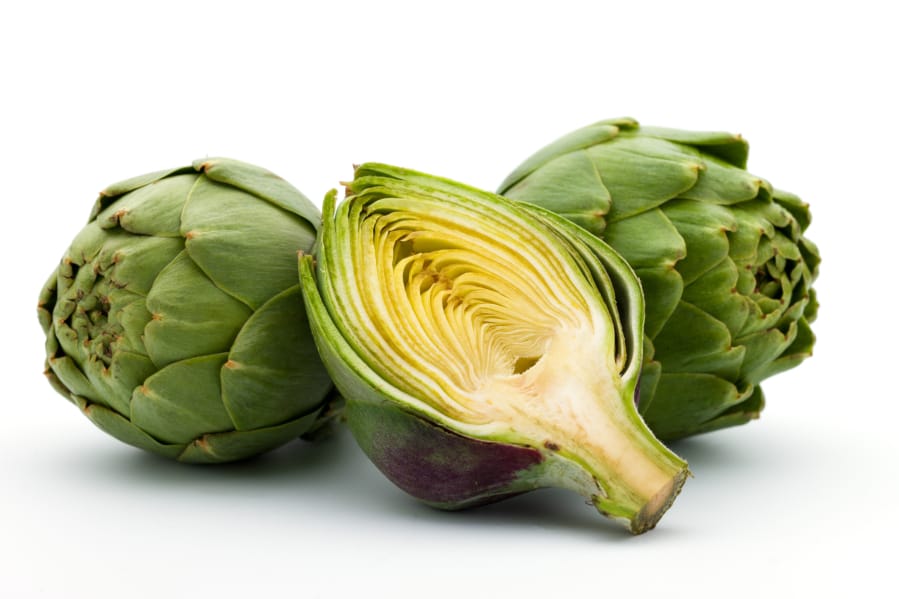Artichokes are an interesting flowerlike but prickly vegetable. Also known as globe artichokes, they are really the bud of a large plant from the thistle family. If it is left on the plant, the bud will become an inedible blue-violet flower.
The large flower bud grows on the top and smaller ones below. The small ones are sold as baby artichokes. Artichokes have a fresh flavor between asparagus and celery with nutty undertones. Globe artichokes are not related to sunchokes, also known as Jerusalem artichokes, which are starchy tubers much like potatoes.
The hearts are the tastiest part of an artichoke. The leaves are tough but after cooking you can scrape the tender parts with your teeth. Large artichokes have a fibrous choke just above the heart and under the woody outer leaves. Its pointy fibers resemble hair and must be removed and discarded. If eaten they can cause one to choke. Baby artichokes are more tender and don’t develop the inedible choke.
Select artichokes that feel heavy for their size. Avoid those with brown leaves that look dry. The leaves should squeak when pressed together. Smaller artichokes have rounder, more tender bulbs and larger hearts.
Unwashed artichokes will keep well in the refrigerator for up to four days. Before refrigerating, slice a small piece of the stem off and sprinkle with water. Place in an airtight bag. Wash just before you cook them. Cooked artichokes will last up to three days refrigerated and covered.
Before cooking, rinse well and scrub with a soft brush to remove the natural coating that causes a bitter flavor. Slice off half inch of the top and snip off the pointy tips of the leaves. The stem is edible, but if you plan to serve them upright, slice it off.
The most common ways to prepare artichokes is by boiling or steaming. Steaming does result in a less waterlogged vegetable. To steam, put artichoke stem side up in a steamer basket over simmering water for 30 minutes. Artichokes cut in half lengthwise will cook more quickly and be easier to serve. If you don’t want to heat up your kitchen, try grilling them.
To eat, remove the outer leaves one at a time and dip in a garlic or lemon sauce and scrape the fleshy tender part of the leaves with your teeth. After eating all the leaves, use a spoon to scoop out the inedible fuzzies. This will reveal the heart and stem which can be cut up into pieces and enjoyed with the dipping sauce.
Artichokes are a great vegetable to prepare ahead. Steam them the night before and then reheat before serving or use as an ingredient to a favorite recipe. To reheat, drizzle with olive oil, a tablespoon of water, cover and heat for 30 minutes. Reheat in the microwave for 20 to 60 seconds.
Sandra Brown is a Washington State University emeritus faculty member and a WSU Clark County Extension Master Food Preserver. For additional recipes, food preservation and food safety information visit http://ext100.wsu.edu/clark/?p=1134. Have questions? Call MFP helpline at 360-397-6060 ext. 5366, or follow at www.facebook.com/WSUClarkCo.MFP.
Garlic Grilled Artichokes
Yield: 4 servings. Source: Chef Scotty
2 large artichokes
2 tablespoons fresh lemon juice
4 cloves garlic, minced
Salt and pepper to taste
In a large pot, bring 3 quarts of water and 1 tablespoon of salt to a rapid boil. Trim the tops of the artichokes and cut in half lengthwise. Add to boiling water and reduce heat to maintain a slow boil. Cook for 15 minutes then drain.
Whisk together lemon juice, garlic, salt and pepper in a mixing bowl. Brush artichokes with the garlic sauce and place over medium high heat on a well-oiled grill. Grill for 6-8 minutes, basting with more garlic sauce and turning often until the tips are slightly charred. Serve with the remaining garlic sauce.




